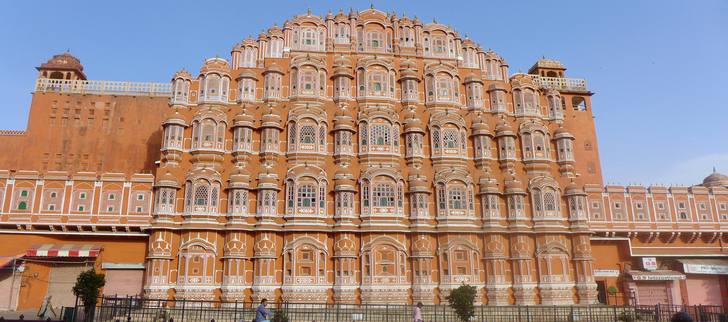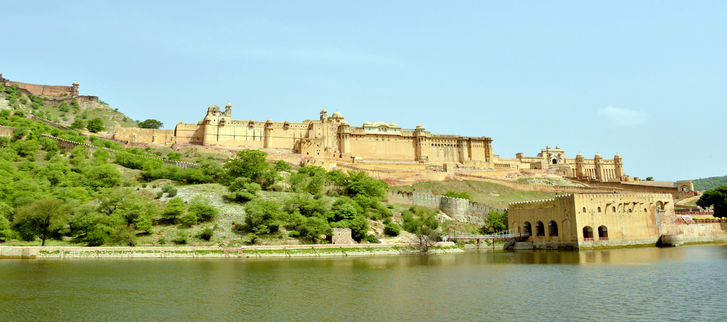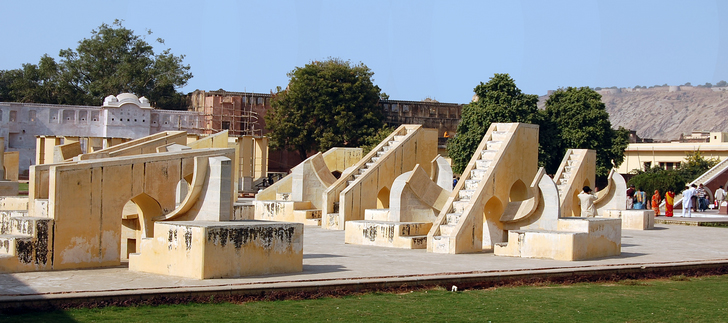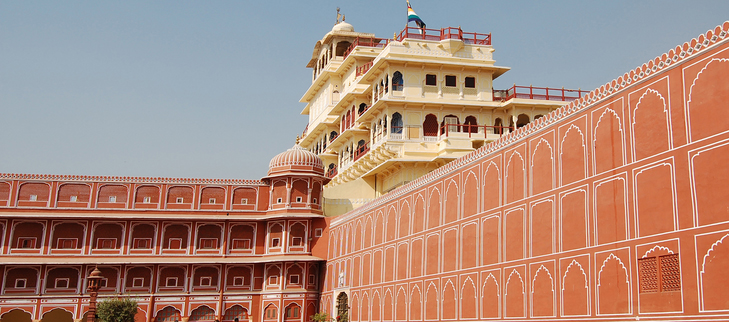Sights in Jaipur

Hawa Mahal, meaning Palace of the Breeze, was built in 1799 by Maharaja Sawai Pratap Singh, and designed by Lal Chand Usta in the form of the crown of Krishna, the Hindu god. Its unique five-story exterior is also akin to the honeycomb of a beehive, with its 953 small windows called jharokhas that are decorated with intricate latticework. Go to the Hawa Mahal Page.

Set in Jaipur’s spacious Ram Niwas Gardens, this stately building designed by Sir Swinton Jacob was modeled on London’s Victoria and Albert Museum. Combining the elements of English and north Indian architecture, it was known as the pride of the New Jaipur when it opened in 1887 AD. It houses a collection of exhibits of Rajasthani folk arts. Various other exhibits include rare stone carvings dating back to the 2nd century and some fine miniatures along with an Egyptian mummy. But the prize possession is a magnificent late 16th century Persian garden carped, considered one of the finest carpets ever woven.

The Jantar Mantar is the most iconic attraction of Jaipur which is the largest city and capital of the western Indian state of Rajasthan. The Jantar Mantar is the name of the celestial observatory built by Maharaja Jai Singh II, the founder of the city of Jaipur. Go to The Jantar Mantar Page

The City Palace, which includes the Chandra Mahal and Mubarak Mahal palaces and other buildings, is a palace complex in Jaipur. It was the seat of the Maharaja of Jaipur, the head of the Kachwaha Rajput clan. The palace complex incorporates an impressive and vast array of courtyards, gardens and buildings. Go to the City Palace Page.
Jaigarh Fort was built between the 15th and the 18th century and is located on one of the peaks of the Aravali range of hills. It provides an excellent view of the Aravali hills and the Amber Fort down below. Jaigarh Fort stands amid rock-strewn, thorn-scrub covered hills, and its foreboding stone ramparts are visible from Jaipur, 15 km away. A steep road goes up to the main gate, the Dungar Darwaza. Jaigarh Fort is the most spectacular of the three-hilltop forts that overlook Jaipur. Jaigarh Fort is also known as the Fort of Victory. In Mughal times, the Jaipur region was a major weapon-producing center for the Mughal and Rajput rulers. Several of these weapons are on display in the fort's armory and museum. It is one of the few military structures of medieval India preserved almost intact; the fort contains palaces, a granary, a well-planned cannon foundry, several temples, a tall tower and giant mounted cannon-the Jai Ban, which is the largest cannon on wheels in the world. The armory display includes a collection of canons, many of which are exquisitely decorated and were used in the Mughal campaigns led by the, Rajput King, Raja Man Singh.
Nahagarh Fort stands on the edge of the Aravali Hills, overlooking the pink city of Jaipur. The view of the city from the fort is breath taking. Along with Amber Fort and Jaigarh Fort it formed a strong defensive ring for the city. It was built in 1734 and extended in 1868. The fort’s thick ramparts and arches make it a superb example of Rajput military architecture. By the 19th century, Nahargarh Fort was converted to more peaceful purposes, and a palace was built here, with delicately cusped arches and ornately frescoed walls. The palace contains suites for the Maharaja and each of his nine queens. All of them are notable for the beautiful florally painted arayish on their walls, which is still amazingly well-preserved. The palace complex is laid out with courtyards and terraces, and a Hawa Ghar (breeze chamber) with a beautiful view of the city.
The Lakshmi - Narayan Temple, also known as Birla Mandir, is a modern architectural wonder. The grand temple is located on an elevated ground at the base of Moti Dungari hill in Rajasthan. Built entirely in the finest quality white marble, the temple has some beautifully carved sculptures and idols. It is dedicated to Lord Lakshmi Narayan also known as Lord Vishnu of the Hindu trinity. The three main domes of the temple represent a very clear picture of secular India as they portray different approaches to the religions of the nation. The temple has some of the most beautifully crafted idols of Lord Ganesh and other Hindu Gods. Along with the idols of Gods, one can find statues of great thinkers and philosophers like Buddha and Socrates. Birla Mandir comes to life as a magical palace during the festival of Janmashtami, which is celebrated to mark the birth of Lord Krishna. The whole temple is decorated beautifully with flowers, and in the evening, the temple glows as it is illuminated with a thousand lights.
Set in Jaipur’s spacious Ram Niwas Gardens, this stately building designed by Sir Swinton Jacob was modeled on London’s Victoria and Albert Museum. Combining the elements of English and north Indian architecture, it was known as the pride of the New Jaipur when it opened in 1887 AD. It houses a collection of exhibits of Rajasthani folk arts. Various other exhibits include rare stone carvings dating back to the 2nd century and some fine miniatures along with an Egyptian mummy. But the prize possession is a magnificent late 16th century Persian garden carped, considered one of the finest carpets ever woven.
Located 6 miles east of Jaipur is Sisodia Rani Ka Bagh, a little palace lad out in formal terraced gardens with fountains. It bears the name of the clan of a princess from Udaipur who was married to Raja Sawai Jai Singh II. It was merely a political marriage between the two antagonistic states, one of the terms of which was that the son born of this union would succeed to the Jaipur throne. But tired of the constant intrigue against her at Jaipur’s City Palace and fearful for the life of her son, the unhappy princess came here to live under its domed and canopied roof. The upper story of the palace has some charming murals of hunting scenes, polo matches, mythical beasts and episodes from the life of Lord Krishna and his beloved Radha.
A vital part of the City Palace complex, this Krishna temple has been highly revered by the royal family. Sawai Jai Singh installed the image of Govind Dev ji (an incarnation of Lord Krishna) after it was brought from Vrindavan. Housed within the sanctum of this spireless temple, the patron deity of the royal family is worshipped by most of the Hindus in the city and nearby areas. The image is unveiled seven times daily for prayers and offerings. The idols of Radha-and Krishna are dressed in different styles each time for the procession where thousands of devotees gather around the courtyard.
The Temple of Galtaji is an ancient pilgrimage site famous for its natural water springs. Temples, pavilions and holy kunds (natural springs and water tanks) can be found among the lush landscape of the complex. In all, there are seven tanks, the holiest being the Galta Kund, which never goes dry. It is considered auspicious to take bath in the holy waters of Galtaji. Thousands of people come every year to take a dip in the tanks to rinse out their sins. The main temple is the Temple of Galtaji, built in pink stone. It is famous due to the large tribe of monkeys who live there. Another temple of note within the complex is the Surya Temple dedicated to the Sun God. The temple is decked with rounded roofs, exquisitely carved pillars and painted walls.
Moti Doongri Palace stands out eccentrically among the old Rajput palaces. Originally a small fort called Shankar Garh (Shiva’s Fortress), it was renovated by Maharaja Sawai Man Singh II and restyled to look like a Scottish castle. It was one of Maharaja Sawai Man Singh II’s favorite palaces and was the location for glittering parties that he hosted for his intimate circle of friends.
The Kanak Vrindavan is an exquisitely landscaped garden with a beautifully carved temple. It is a vast complex with terrace sites all around and intricately carved marble columns and lattices. Located in the foothills of Nahargarh on the way towards Amber, this complex is a popular spot for picnics and film shoots.

